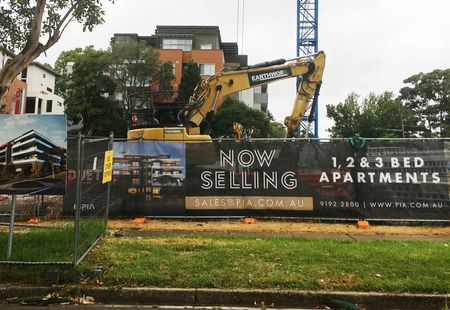
By Vivek Mishra
BENGALURU (Reuters) – Rampant rises in Australian house prices will grind almost to a halt this year, and an 8% decline is expected in 2023 as a cost-of-living crisis worsens and mortgage rates rise, a Reuters poll of property market analysts found.
Cheap loans based on near-zero interest rates have nearly doubled house prices since the global financial crisis of the late 2000s, turning Australia into one of the world’s least affordable places to buy property.
Prices surged over 20% last year, the biggest annual increase since 1989, making it much harder for first-time buyers to get on the property ladder.
That blistering pace will slow to just 1.0% this year, according to the median forecast in the May 11-25 poll of 11 analysts, down sharply from 6.7% forecast in a February poll.
Prices are forecast to drop 8.0% next year, more than the 5.0% expected in the previous survey.
“The risk of a crash cannot be ignored, given the high level of household debt and that it’s been more than 11 years since the last rate hike,” said Shane Oliver, chief economist at AMP, who expects house prices to fall 10-15% into 2024.
2efd351e-c305-4b4a-b936-fe23fccdf5f41
RECORD MORTGAGE DEBT
Australia’s central bank this month raised its cash rate for the first time since November 2010, by 25 basis points to 0.35%, and flagged more hikes to come.
A sudden rise in borrowing costs could sharply dent housing activity, in a country where about 6% of employment is closely tied to the residential construction sector, eventually leading to slower economic growth.
“A steep increase in mortgage rates over the coming year will weigh heavily on house prices,” said Adelaide Timbrell, senior economist at ANZ.
It will also be a challenge for heavily indebted households in a country which has a record A$2 trillion of mortgage debt outstanding.
A substantial decline in prices is needed to make housing more affordable for those who don’t already own.
“A very large correction in prices would be needed to enable ‘affordable’ housing, particularly in Sydney and Melbourne, though the wage outlook is key to how much of a correction would be needed,” Timbrell added.
Wages are lagging, at least by the official measure which showed annual pay growth ticked up only slightly in the first quarter to 2.4%, half the pace of inflation.
Both ANZ and Knight Frank said average prices would have to fall 40% – roughly the amount U.S. house prices tumbled during the global financial crisis – to make Australian housing affordable.
House prices in Sydney and Melbourne were forecast to fall 2.5-3.0% this year and 9.0% next. In Brisbane, Adelaide and Perth, prices were expected to rise 2.0-6.5% this year but decline 4.5% in 2023.
(Reporting by Vivek Mishra; Polling by Arsh Mogre and Md Manzer Hussain; Editing by Ross Finley)

